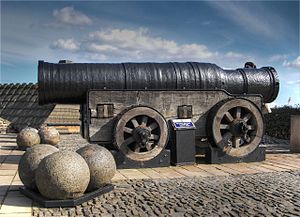Mons Meg facts for kids
Quick facts for kids Mons Meg |
|
|---|---|

Mons Meg with its 20" (510 mm) caliber cannon balls
|
|
| Type | Cannon |
| Place of origin | Mons, Duchy of Burgundy |
| Service history | |
| Used by | Kingdom of Scotland |
| Specifications | |
| Mass | 6.6 t |
| Length | 406 cm |
| length | 280 cm |
Mons Meg is a giant cannon from the Middle Ages. It was built in 1449. Today, you can see this huge weapon at Edinburgh Castle in Scotland.
Unlike modern cannons that fire explosive shells, Mons Meg shot solid iron balls. It was made for Philip the Good, Duke of Burgundy, around 1449. He later gave it as a gift to King James II of Scotland.
Mons Meg is super heavy, weighing about 6.6 tons (15,366 pounds)! It is 4.6 meters (15 feet) long. Its barrel is 510 mm (20 inches) wide.
History of Mons Meg
How Mons Meg Was Made
This massive cannon was made from long iron bars. These bars were then wrapped tightly with iron rings. All these pieces were fused together to create one strong weapon.
The Duke of Burgundy's artillery maker built Mons Meg. It was tested in June 1449 in Mons, Wallonia. The Duke finally received it in 1453.
The Duke decided to help the Scots fight against the English. So, he sent Mons Meg to King James II. King James II brought many cannons from Europe during his time. He used them to fight his enemies in Scotland. Sadly, King James II died in 1460 when a cannon exploded during a battle.
There is another story about Mons Meg. Some people think it was made to help King James II in 1452. This was during a battle at Threave Castle. In this story, a group called the Clan MacLellan used it to attack the castle. However, this story does not have much proof.
Mons Meg in Action
The 510 mm (20-inch) wide cannon fired huge balls. Each cannonball weighed about 180 kg (400 pounds). Because of the huge amount of gunpowder needed, it could only be fired 8 to 10 times a day.
In its early years, Mons Meg was painted with red lead. This was done to stop it from rusting. This painting cost 30 shillings in June 1539.
After the 1540s, Mons Meg was no longer used in battles. It was only fired for special events from Edinburgh Castle. When it was fired, the cannonballs could travel up to two miles away!
On July 3, 1558, Mons Meg was fired to celebrate. This was for the marriage of Mary, Queen of Scots to the French Dauphin. Workers were paid to find and bring back the cannonball from a place near the River Forth.
The cannon was fired again in 1680. This was to celebrate the arrival of James, Duke of Albany and York. He later became King James II of England and VII of Scotland. But this time, the barrel burst!
An English cannoneer had loaded the cannon. Many Scots believed the damage was done on purpose. They thought this because the English did not have a cannon as big as Mons Meg. People also saw this accident as a bad sign for the future King.
After the barrel burst, the cannon was left outside Edinburgh Castle. In 1754, it was moved to the Tower of London. But in 1829, it was brought back to Edinburgh Castle. This happened after a campaign by the famous writer Sir Walter Scott.
Mons Meg was repaired and restored. Now, it sits proudly outside St. Margaret's Chapel at Edinburgh Castle.
Images for kids
-
The Dulle Griet on display in Ghent
-
Engraving of Mons Meg at Edinburgh Castle in the 1680s, showing details of the carriage construction
See also
 In Spanish: Mons Meg para niños
In Spanish: Mons Meg para niños






